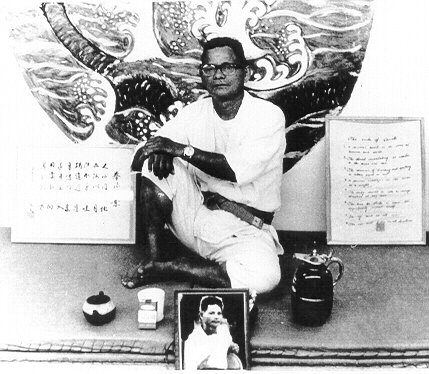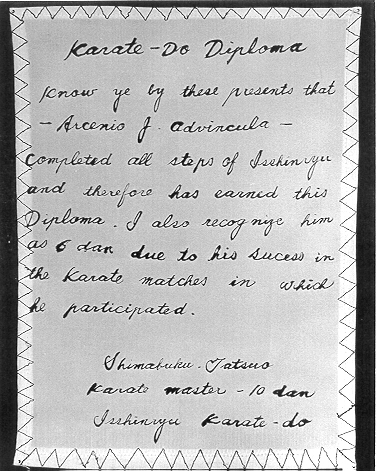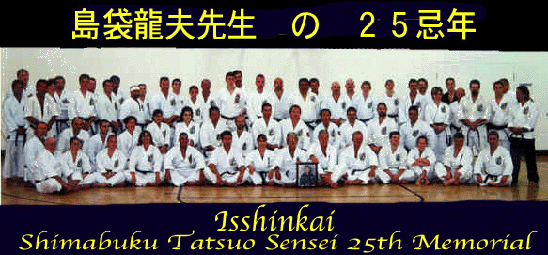Shimabuku Tatsuo Sensei
His Teachers • DRAGON MAN • 24th Anniversary • Tatsuo's 91, 9, 19, 1999 • MemorialSHIMABUKU TATSUO
![]()
"DRAGON of Isshin-ryu in the year of the DRAGON" - Sept 19, 1908 - May 30, 1975
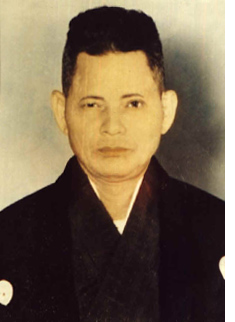 Shimabuku Tatsuo the "Dragon Man" of Isshin-ryu was born in Meiji 41, in the year of the "Monkey". This year is Heisei, the year of the "Dragon", Tatsuo would be 92 years old. It has been 33561 days since he was born at Chan Settlement, Okinawa.
Shimabuku Tatsuo the "Dragon Man" of Isshin-ryu was born in Meiji 41, in the year of the "Monkey". This year is Heisei, the year of the "Dragon", Tatsuo would be 92 years old. It has been 33561 days since he was born at Chan Settlement, Okinawa.Being a sumuchi, he studied the oriental star constellations. One constellation, "The East Dragon", was the inspiration for naming his system Isshin-ryu. Tatsuo also took his name from the Dragon of the East. the heart of the dragon and named his system Isshin-ryu. We can see in the picture of the Isshin-ryu Megami (![]() ) that there are three stars in line in the shape of one (***) in kanji (
) that there are three stars in line in the shape of one (***) in kanji (![]() ). The three stars are the heart
). The three stars are the heart ![]() of The East dragon. The same three stars are also the heart of Scorpio.
of The East dragon. The same three stars are also the heart of Scorpio.

Ryuzu Kannon, The Goddess (Megami) of mercy is represented by a woman standing on, near or riding a dragon or turtle.

The name Isshin-ryu is found in the symbol of the Megami ??. The three stars on line (***) stand for the kanji or Chinese character ( "Ryu" is a homophone or a word having the same sound as another word but differing from it in spelling, origin, and meaning; For example, English "sum" and "some" are homophones. Another example is "night" and "knight". In Japanese, "ryu" "All things in the universe will change." Shimabuku Tatsuo Sensei, founder of Isshin-ryu Karate and Kobudo / by A.J. Advincula (1997) Shimabuku was born in Chan village now called Kinaka in Gushikawa City on September 19,1908. He was given a girls name as was the custom adopted by the Okinawan's from the Chinese to fool the malevolence spirits lurking about who would try to harm the new born baby. It was thought that the ill willed spirits would look for a girl baby only and not harm the the boy baby. Only after they fooled the evil spirits would they have given the baby the Okinawan name Kana and the Japanese name Shinkichi. Shinkichi is the name found on Shimabuku's koseki or family register and was also on his passport when he visited the United States in 1964 and 1966. Prior to the Japanese making Okinawa a Japanese prefecture in 1879, and later passing laws abolishing certain kanji or Chinese characters for names used by Okinawan's to name their children, Okinawan names where given to new borns. The reason the Japanese did this was to subject the Okinawan's into being Japanese and stop them from using Okinawan customs . The Okinawan's were forced to cut their topknots which they were allowed to wear when they interred manhood and were also told not to speak Okinawan hogen or dialect but to only speak Japanese. Still Okinawan's gave their children Okinawan names although they couldn't put them on their koseki. Kana first studied martial arts from this uncle on his mother's side Ganeku. Ganeku also taught the young Shimabuku to be a sanjinsoo,a practitioner who engages in fortunetelling, divining, and geomancy and deriving their knowledge from books rather than from the supernatural. The I Ching and kuyumi or lunar almanac besides other books on occult lore are some of the books the young Kana would have to learn. These ancient books would have been written in kanji and he would have to learn how to read the Chinese characters. Ganeku thought he did not have enough martial arts knowledge so he sent Shimabuku to study karate from Chotoku Kyan who lived in Kadena,. At the time, Shimabuku who was around age 23 or 24, and a poor farmer's son,walked barefooted to study with Kyan. He would stay for six hours and come back home to do his chores with the farm. He studied Shuri te with Kyan for four years. Shimabuku would tell of Kyan practising chinto kata on a bridge and said chinto kata was good for that purpose. Shimabuku studies Naha te from Chojun Miyagi around 1936. Again he walks but this time a much further distance to Naha. This time he stays with Miyagi for three years. Miyagi was known for his gripping techniques and Shimabuku put a gripping technique into his own kata sunsu. In 1938 at age 30 he studies with Choki Motobu again in Naha for one year. Motobu was known for his fighting ability and Shimabuku always told a story about Motobu peeking through a fence to learn naifanchi kata. The reason for this was to show it wasn't the amount of kata one knows but how will one know it. In 1939 Shimabuku goes to the Philippines and stays for two years leaving for Osaka before the war begins in 1941. In Osaka he becomes a bucho or general supervisor and stays until around 1944 when he returns to Okinawa to take his family to Kyushu, Japan to protect them from the war. While in Japan, Shimabuku works as a farmer. One year after the war, he brings his family back to Okinawa. At age 39, in 1947, Shimabuku begins teaching karate at different locations. At first he calls his karate Chan migwa karate after Chotoku Kyan's nickname. He also takes the name Tatsuo meaning dragon man at this time. Around 1951 he was calling his karate Sun nu su karate after his nickname he received from the mayor of Chan when Shimabuku worked as a tax collector a few years before. The mayor named him after a dance that Shimabuku's relative had made called Sun nu su. Sun nu su means son of old man. He later shortens it to Sunsu. On January 15,1956, Tatsuo holds a meeting and names his style of karate Isshin-ryu karate. Eiko Kaneshi his right hand man said,"Why Isshin-ryu,why such a funny name," and Tatsuo replied, " Because all things begin with one." Much of what most Americans know about Sensei Shimabuku has been passed down to them by those who studied with him on Okinawa. Most of these Americans were marines with a few navy, army and one airforce serviceman. The majority of them studied on one tour of duty with a tour being less than eighteen months. None got to know him very well but some came back and stated they were his top student, number one student, senior student, or best student and one claims to have been Okinawan champion as a white belt beating all of Okinawa's black belts. Many times I'm asked if such things happened or whats do you remember. Each of us remember his own story but every since I've started I've been taking notes,photos, recording,filming, and now video taping all interviews. Many told stories or tales that never happened. Others exaggerated and told unbelievable feats for example; I heard that one person stated that he saw Tatsuo drink boiling hot tea from a tea kettle. Another high ranking person who was never on Okinawa says he personally saw Shimabuku climb upside down up a flagpole at or near the dojo . The thing that's wrong with the first story is its not believable, and the second story about the flagpole that makes it made up is that there was no flagpole. Known facts are that Tatsuo could drive a 16 penny common nail into a 2x4 with the edge of his hand and with the heel of his foot. I've observed both these feats. Sheisho Tokumine who started with Tatsuo in 1951 says he saw Tatsuo chop the tops off of the neck of a glass bottle, and saw him climb up a telephone pole head first near Agena dojo and come down the other side head first. Art Smiley who started in 1956 said he also saw Tatsuo climb a telephone pole in Agena and said he filmed it. Tatsuo always said the reason for being able to do these feats was that he was in good physical shape. The training he did to drive a nail through a 2x4, was to hit the edge of his hand on the edge of a tapered 2x4 for about twenty to thirty minutes each day. Tatsuo was an innovator and not a perfectionist. He believed in being natural and spontaneous. This is one of the reasons that he rarely did his kata exactly the same way each time. He also believed in change and being a sumuchi another name for a fortune teller that uses ancient books from China to tell fortunes shows he was well versed in the I Ching. The Ching is The book of change. Tatsuo while explaining the 5th verse of the Kenpo gokui said." All things in the universe will change, and you must accept and go with change." This is only one of his interpretations of this code. He always stated not to be rigid in body or in life. He said to go with the times and be happy and joke for he liked to joke. Major Mike (Maekawa) who started the same time Tokumine did said, "Tatsuo liked to drink sake (liquor), eat yaki soba (fried noodles) and tell jokes." Major Mike recalls that Tatsuo asked him if he thought he was good in karate and Major Mike said yes. " Get a gun," Tatsuo replied to Maekawa's answer. Eiko Kaneshi Tatsuo's right hand man who started in 1947 said that he had studied karate from others including Shoshin Nagamine of Matsubayashi-ryu karate but no one had chinkuchi ( technique,controlled power,ki or chi ) like Tatsuo. Tatsuo's feelings were hurt by some of the senior Masters from Naha who did not agree with his new style of karate. Once while sitting in the dojo after class several of us were sitting and drinking. Tatsuo liked to drink Awamori an Okinawan distilled alcohol made from certain type of long grain rice which comes from Southeast Asia. There were many bottles of awamori,pine juice, and beer of various sizes on the table. Others present were drinking beer or mixing the awamori with pine juice a pineapple juice. Tatsuo asked the students "Which is the best bottle?" Those who were drinking beer stated the beer bottles,others picked the largest bottles,and some chose the smaller bottles. Shimabuku said all the bottles were good. All of them served a purpose: to hold what they were intended to. " There is no best bottle," he said. What Tatsuo was saying was each had a purpose and all were good. He was relating this to karate. Not all of the other martial arts masters disagreed with Shimabuku. He was good friends with Kane Uechi of Uechi-ryu and did demonstrations with many of the other top masters. Isshin-ryu stems from three different styles of martial arts. As one of his interpretations of the three stars in the Isshin-ryu Megami stand for, Shorin-ryu, Goju-ryu, and Kobudo. Tatsuo said that Shorin-ryu's naihanchi was the mother, and Goju-ryu's sanchin was the father, and from this union the offspring was Isshin-ryu. At age 51,Tatsuo begins to learn Shinken Taira kobudo and incorporates it into Isshin-ryu. Prior to learning from Taira, Tatsuo taught a sai kata now known as Kyan Chotoku no sai or for short Kyan no sai. He also taught Tokumine no kun which he learned from Kyan. Tatsuo Shimabuku in 1951 taught these following kata according to Tokumine and Major Mike: Seisan,seienchin (seiunchin), naihanchi (nahanchi shodan), wansu,chinto,kusanku,sunsu,sanchin,sai kata (kyan no sai), kusanku sai, tokumine no kun. Around 1959-61, he adds from Taira's kobudo, chatan yara no sai, urashi kun, shishi no kun and tuifa kata (Hamahiga no tuifa). In 1971, Tatsuo retires from teaching karate and kobudo but still gives out promotions or attends some dojo functions. His last official act in martial arts was to attend the grand opening of the Isshin-ryu Headquarters Dojo in Kinaka in April of 1975. On May 30,1975, the dragon of Isshin-ryu died of a stroke. Some say from a broken heart. From his students, all we can say is, thank you Sensei for teaching us. Let us in Isshin-ryu commemorate the birthday of one of the first modern karate masters who looked at change in a positive light. On May 30,1975, The founder of Isshin-ryu Karate passed away from complications caused by a stroke. I remember passing Sensei Shimabuku’s house on my way home in Taba, Gushikawa. I had to pass his house on the way home and saw a notice in Japanese kanji or Chinese characters posted on the front entrance of his house. I knew something was wrong and later found out that Sensei had passed away. I went to Kichiro’s home and paid my respects at his family alter. Thirty days before I took Tatsuo to the grand opening of the then new Kinaka dojo. At the time he looked in good health so his death was a shock to me.It is now 24 years that Master Shimabuku has passed away. He was 66 years old when he died and would have been 90 years old today had he lived. Shinsho Shimabuku, Tatsuo’s second son, told his father to have a photo taken that would be used in all the dojo of his followers. Tatsuo dressed in a formal kimono and had the photo taken. On his kimono, was two Tomoe or Hidari Mitsudome. The Tomoe were the crest of the Okinawan Royal family. There is a story about why the Tomoe or crest was adopted by the Okinawan King. After the Satuma evasion in 1609, the King of Okinawa, Sho Nei, along with other high ranking officials who were prisoners, were taken to the Satuma conquerors to sign an oath of allegiance. Tei Do , one of the Okinawan Councillor’s, refused to sign the oath of allegiance to the Satsuma. As a result of his refusal, Tei Do was sentenced to death by boiling oil. As he was being led by two of the guards on top of a scaffold near the top of the boiling oil vat, before he could be tossed into the oil, he is said to have grabbed the two guards and jumped into the oil with them shouting that he would take them to hell with him. It is not hard to imagine the three of them whirling in the vat of boiling oil. The three coma shapes denote the three of them whirling . Historically accurate or not, it is a good story that is passed on since the Satsuma evasion of 1609. The Hidari Mitsudomoe or Tomoe can be seen on many items on Okinawa both ancient and modern. Most martial art dojo on Okinawa use this symbol on certificates or in other forms. Today it stands as one of the symbols for Okinawa. On his 24 anniversary of Tatsuo’s death, let us all pay respects to our founder, Shimabuku Tatsuo Sensei. April 1999: Tomo No Kai at seimei festival. Picnic at tomb during seimei festival , Taba, Gushikawa, Okinawa. Tomo No Kai Cultural Martial Arts Tour No.5. April, 1999. Last month in April I saw Shinsho Shimabuku on Okinawa. He was just recuperating from having a stroke. He reminded me to tell all to pay their respects to his father. While on Okinawa I visited Tatsuo’s family tomb twice. Shinsho Shimabuku, Tatsuo’s second son in center, at Kinaka, Gushikawa, Okinawa. Shinsho said not to forget to have a memorial for his father who died, May 30, 1975. Left-Right. Carol Womack, Cherry Douglas, Shinsho Shimabuku, Marien Jumelet, Kensho Tokumura and Jeff Perkins. Tomo No Kai Tour No. 5. April 1999. Let us remember the man who gave us Isshin-ryu and pass on his teachings for he was not just another teacher, he was the teacher. Today several of Tatsuo’s students have joined him. Eiko Kaneshi his right hand man, Kenji Kaneshiro, the person who brought the first karate gi to Tatsuo in 1947 at the Tairagawa dojo, Don Bohan and Harold Long. Many a night after our karate training we would have a few drinks with Sensei. All who have been to Okinawa know this to be a Okinawan custom. Last month on Okinawa the Okinawans had what is called seimei festival. In April, the Okinawans visit and clean the tombs cutting away weeds and then address prayers for health, prosperity and peace to the ancestors. To the Okinawans this is a festive occasion, and a family reunion with the ancestors. A oju or picnic lunch is carried. The food of meat, rice, fruits and vegetables is shared with the ancestors through offerings on the family alter within the tomb. Tatsuo Shimabuku's family tomb. Kensho Tokumura on our first day on Okinawa took us straight to pay our respects to the family tomb of the Shimabuku family. Left to right. Byron Marriner, Cherry Douglas and Marien Jumelet. Tomo no kai tour No 5. April 15, 1999 Chibana, Okinawa. Tatsuo’s favourite drink was the Okinawan saki (liquor) called awamori. It is a distilled alcohol made from imported rice from Thailand and can be up to 45 proof. I have some awamori and on the 30th of this month will toast him. Thank you for teaching Sensei, Kanpai. A. Tatsuo posing in natural stance. - B. Tatsuo posing in natural stance wearing a red belt. - C. Tatsuo performing Sanchin Kata using the vertical
punch. Photo taken in the late 1950's
In 1969, I asked Tatsuo which punch did he want us to use. In the past he allowed us to use either the twist or vertical punch. The reason was to appease some of his old Okinawan students who disagreed with him. Tatsuo then told me either punch was ok. I again repeated the question. "But which one do you believe is the superior punch?" Again he said either was ok. Again I asked, "But which one do you think is the best?" Tatsuo answered the vertical punch was the best punch because it was faster and more natural.Of course, stupid, I said to myself, it's his creation. It is one of the things that make Isshin-ryu. The vertical fist is the trademark of Isshin-ryu and can be proved to make the wrist stronger. To test this, all you have to do is get a person to try and bend your wrist while make different fists. The further the thumb comes down along toward the middle finger, the weaker the wrist.The muscle block again is the stronger block. You don't see them breaking 2x2's over the bone of the forearm do you?! They always break over the muscle. Advincula breaking 2x2 over C.G.Bess' forearm at Parris Island, S.C. 1974 Father SHIMABUKU SHINKICHI (Tatsuo) passed away at 10:30 AM on 30 May 1975, while being treated for illness. We would like to thank all of you for your friendship while he was alive. The viewing shall be held at our home (Gushikawa City, Kinaka 829) from 4:00-5:00 PM on 31 May 1975. 31 May 1975 Eldest Son Shimabuku Kichiro, Second Son Shimabuku Shinsho, Second Daughter Higa Matsuko., Third Daughter Uezu Yukiko, Family Members and Friends. Founder SHIMABUKU TATSUO (Shinkichi) has passed away on 30 May 1975. We announce this to all concerned parties. 31 May 1975 Isshinryu Kokusai Karate Renmei President Shimabuku Shinkichi, Officers and Students. Translated by Joe Swift While Tatsuo's body was laid to rest, his spirit is always with us. Each person who wears the Isshin-ryu patch not only honor the ideals of Tatsuo and Isshin-ryu but Tatsuo himself. For in the symbol are all the essential elements of Tatsuo's thoughts and beliefs. All the following are depicted in the Isshin-ryu symbol: All Tatsuo's teachers (3 stars are symbolic for plural or all)Kenpo Gokui or Code of Karate (Symbolic)
Shorin-ryu, Goju-ryu and Kobudo (3 stars)Naihanchi mother, sanchin father and off-spring Isshin-ryu (3 stars)
Karate is golden and should not be misused (Gold border)The fist of Isshin-ryu (Outline of the patch)The name Isshin-ryu (3 stars and Dragon)Isshin-ryu only for self defense (Open and closed hand) So when you wear a Isshin-ryu patch, you honor Tatsuo and Isshin-ryu. If you look closely you can see Tatsuo emerging from the waters of the earth into the heavens and retuning in a never ending cycle bringing his spirit to his followers and the spirit never dies. "A persons heart is the same as heaven and earth, just as the blood circulating is similar to the moon and sun. To all, please honor Shimabuku Tatsuo Sensei on this 26 Memorial. September 19, 1908-May 30, 1975. AND THE DRAGON (TATSUO) RETURNS The ISSHINKAI originated in Okinawa with 1st generation students of Shimabuku Tatsuo. They would occasionally meet to socialize and discuss "the old days", preserving the memory and teachings of Shimabuku Tatsuo Sensei, the founder of Okinawa Isshinryu Karate. This tradition continues today. (photo courtesy of A.J.Advincula Silk certificate in English given to early American students of Shimabuku Tatsuo upon leaving Okinawa. On October 21, 2000 the IsshinKai conducted a demonstration in Oceanside, California to honor the 25th anniversary of Shimabuku Tatsuo's death, the founder of Okinawa Isshinryu Karate. Sensei A.J. Advincula led the group in Isshinryu Karate basics and kotekitai as taught by his teacher, Shimabuku Tatsuo. Representatives from each dojo demonstrated kata, weapons and kumite. Sensei Advincula ended the demonstration with his powerful performance of Sanchin kata, completing 25 finger jab/tear techniques in honor of the 25th anniversary. Approximately 56 karate-ka from 15 States and B.C., Canada attended.![]() ) one (ichi) or (is). The three stars (***) are the "Heart (Shin)" of the "Dragon" or "Scorpio".
) one (ichi) or (is). The three stars (***) are the "Heart (Shin)" of the "Dragon" or "Scorpio".
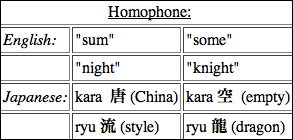
![]() , meaning a way, a style or a mode and "ryu"
, meaning a way, a style or a mode and "ryu" ![]() or
or ![]() , meaning dragon are homophones. Both are pronounced the same. "Kara" meaning "China"
, meaning dragon are homophones. Both are pronounced the same. "Kara" meaning "China"![]() and "kara"
and "kara" ![]() meaning empty are also homophones.
meaning empty are also homophones.
HIS TEACHERS
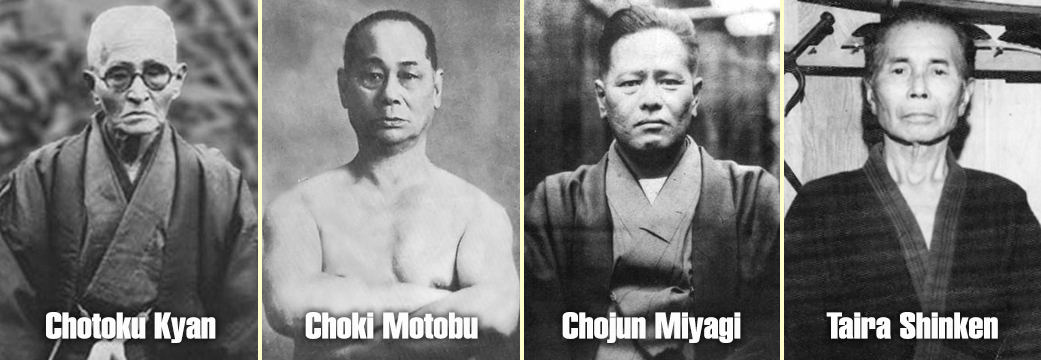 Chotoku Kyan was born in Shuri, Okinawa in December 1870 and was the first son of Chofu Kyan. Chofu Kyan had been a descendant of the fourth Ryukyuan king, Shoshi. Kyan (also sometimes pronounced Kiyuabu) was born a frail child, but through his martial arts training he developed into a strong adult and his health improved much. He had begun his training in karate-do at the age of five years old.
(click here for Kyan Info.)
Chotoku Kyan was born in Shuri, Okinawa in December 1870 and was the first son of Chofu Kyan. Chofu Kyan had been a descendant of the fourth Ryukyuan king, Shoshi. Kyan (also sometimes pronounced Kiyuabu) was born a frail child, but through his martial arts training he developed into a strong adult and his health improved much. He had begun his training in karate-do at the age of five years old.
(click here for Kyan Info.)
Choki Motobu In his youth having been born in an aristocratic family, was constantly getting in trouble, and fights, more from the expectation of being treated with respect, that was not forthcoming, than from any inherent meanness. There are those who say that Choki was crazy, mean spirited, and a belligerent fighter, and yet among those who knew him well, he was a refined gentleman, with good manners, and a quiet but humorous nature.
(click here for Kyan Info.)
Chojun Miyagi (1888-1953) is the founder of today's Goju-Ryu karate-do; he was responsible for taking Naha-te and formulating it into a system. Miyagi was Kanryo Higaonna's most talented and chosen pupil. Miyagi came from a rich family of high esteem, ship-owners who imported -amongst others- medicines from China and supplied these to the royal family, the government and business houses.
(click here for Kyan Info.)
Taira Shinken was born Maezato Shinken on the 12th June 1897, in the village of Nakazato'on the island of Kumejima. Officially recorded as Maezato Shinken, he often used his mother's maiden name 'Taira'. He graduated from Nakazato Elementary school and later worked at a mine in Minami Jima. It was during his days working in the mine that Taira Shinken life was dramatically changed.
(click here for Shinken Info.)
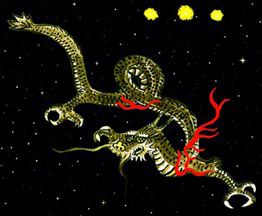 In 1908 a great earthquake shook southern Italy and Sicily killing 150,000 but in the same year Tatsuo Shimabukuro, the founder of Isshin-ryu karate/kobudo was born. Why you ask would one start off a sentence with a tragic event such as a deadly earthquake and end it with a happy event as a birth! Because it is fact and Sensei Shimabuku which he liked to be called instead of Shimabukuro always said," There is good and bad in the universe and we should adapt to all situations." This he got from the Kenpo gokui or Secrets of Kenpo better known to those in Isshin-ryu as the Code of karate which came from the Bubishi a book which came from Fujian ,China and is associated with Okinawan karate.
In 1908 a great earthquake shook southern Italy and Sicily killing 150,000 but in the same year Tatsuo Shimabukuro, the founder of Isshin-ryu karate/kobudo was born. Why you ask would one start off a sentence with a tragic event such as a deadly earthquake and end it with a happy event as a birth! Because it is fact and Sensei Shimabuku which he liked to be called instead of Shimabukuro always said," There is good and bad in the universe and we should adapt to all situations." This he got from the Kenpo gokui or Secrets of Kenpo better known to those in Isshin-ryu as the Code of karate which came from the Bubishi a book which came from Fujian ,China and is associated with Okinawan karate.

24 TATSUO SHIMABUKU MEMORIAL ANNIVERSARYS
Tatsuo Shimabuku - September 19,1908 - May 30, 1975 / by A.J. Advincula, May 1999

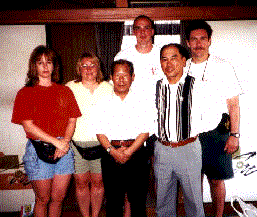
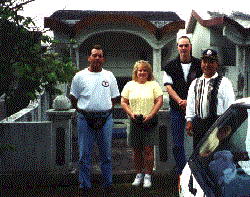
Tatsuo's 91,9,19,1999
Commemorating Tatsuo's 91,9,19,1999 - Shimabuku Tatsuo - September 19, 1908 - May 30, 1975 / by Arcenio J. Advincula
"The bushi uses the natural way and the natural way is to use a straight punch without a twist." --- Kaneshi EikoShimabukuro Kana was born, according to the Nengo or Japanese counting system which uses an era associated with one emperor, in Meiji 41 in the year of the Monkey in the Chan settlement, Okinawa.On the 9th month, 19th day, of the year 1999, Tatsuo would have been 91 years old. Throughout his life he was known as Shinkichi, Kana, Kanahi, Sun nu su, Sunsu, and Tatsuo. He would go by the family name Shimabuku.During different periods of time, he was a farmer, tax collector, bodyguard, karate instructor and sumuchi or fortune teller. When he died on May 30, 1975, he was still doing fortune telling. Before Tatsuo studied karate, he was learning to be a sumuchi from his uncle Ganeku Shinko who later would teach the young Shimabuku shaolin-zi style of karate that he learned in Fukushu (Foochow) China.Today much of the history of Tatsuo has been fabricated. The style he created is drastically being changed by those who never studied or who briefly studied with him. Many are changing what was a punching, striking and kicking style into a grappling style. Even today, after all these years, some still mistakenly call Tatsuo the Dragon Boy when it should be Dragon Man. His birthday an be found on the internet and in books with the wrong years, (1906) or wrong day (September 9). Instead of correcting their mistakes, they constantly perpetuate them.Some claim to teach the lost kata of Isshin-ryu like gojushiho which Tatsuo never liked and stopped teaching. Still others claim to teach kobudo such as kama (sickle) or nunchaku they say they learned from Tatsuo.Tatsuo was an erudite who could read and understand the ancient writings found in the ancient books from China such as the "I Ching", yet he was a humble, non-pretentious man who like to joke. Shinsho, he second son, says, "My father was natural. Look at all the pictures of him standing and you will see that he is relaxed and natural. Watch him doing kata and you will see my father doing it in a natural way."
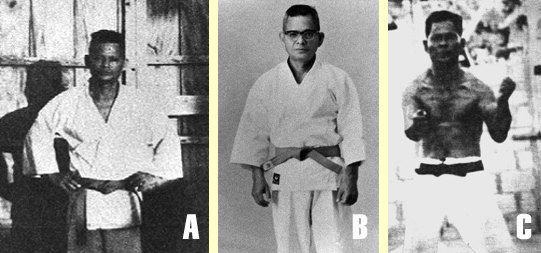
Kaneshi Eiko, with reverence, in an interview said, "When I close my eyes I can see Shimabuku's body doing kata. I'm proud of Shimabuku." Eiko further states that during the January 15, 1956 meeting that Tatsuo called to change from the twist punch to the vertical punch, Kaneshi explains, "The bushi used the natural way and the natural way is to use a straight punch without a twist. So we all decided to use the vertical punch."If Kaneshi Eiko is right that the bushi uses the natural way, then shouldn't we do Isshin-ryu the natural way? When Tatsuo came to the United States in 1964 and again in 1966, he was filmed doing sanchin kata using a twist punch. In all the years while studying with Tatsuo on Okinawa, I never saw him do sanchin using a twist punch. Maekawa, better known as Major Mike , on his view about which punch was better in sanchin says it best, "The use of the twist punch in sanchin is for exercise, but the vertical punch is for combat." And contrary to what some say, Isshin-ryu sanchin is used for both; as an exercise or for combat.

The vertical punch is superior to the twist punch. Now I'm talking about a karate straight thrusting punching. It is faster and for all who do not understand, faster is better. In scientific terms, force equals mass times the square of the velocity. Not only do you get more force, you can throw more vertical punches than twist punches in the same time span. it takes less energy to user vertical punches than twist punches and doesn't karate teach to be efficient by using economy of motion?! It is natural and bushi uses the natural way.While change is natural and inevitable, you don't make change for the sake of change or to be different. Today some Isshin-ryu practioner's do a six count bow but Tatsuo did a two count bow. Why do a six count bow when the purpose of a bow is for courtesy?!Tatsuo taught numerous techniques against grapplers or judo techniques. He would say, "Judo man do this, karate man do this." For the last few years certain people that teach grappling techniques are incorporating them into Isshin-ryu. I have no problem with grappling, having studied combat judo since 1946 when I was eight year old. I also teach grappling, but not in Isshin-ryu as a part of Isshin-ryu. Tokumura Kensho said Tatsuo told him not to grab anyone with two hands because it ties up your hands. Against multiple opponents, grappling is not the best solution.Yes, Tatsuo did some grappling techniques like grabbing the throat, groin, or flesh around the waist. Also blocking and grabbing an opponents arm but notice in over ninety percent of these techniques end with a counter punch, strike or kick. I once attended a tuite seminar and in a span of four hours, four techniques were taught. I couldn't make them work. The seminar was filmed and years later, one person in this style told a friend of mine that he saw the films and said, "Advincula couldn't even do the techniques." My friend replied, "And Advincula is not an idiot." In other words, if it is too complicated remember Murphy's Law.No, Tatsuo was not a complicated man. He was practical. He took what he thought was the best of Shorin-ryu and Goju-ryu and added his own innovations. He eliminated kata and techniques he did not like. Shinsho says his father taught shiatsu te so he would have understood pressure points. He taught some, but when he demonstrated on you, he hit you in the tried and true basic targets like the solar plexus, throat or kidney, or kicked you in the groin, or grabbed your groin or ribs. At that point, you knew you were in trouble. And to this day, no one will be able to convince me that there are better targets than the prime targets; eyes, throat, temple, base of the back of the neck, solar plexus, kidneys or groin. Most of these targets, if hit properly, can cause death. As for disabling, what is better than the elbow, knee and back of the hand or top of the foot, or bending joints in the opposite direction? In the tuite seminar, a person was knocked out with a two finger slap to the side of the neck. This happens a lot to drivers of autos who are slammed hard against the crossover seat belt hitting the large veins knocking off blood supply to the brain. The difference is someone volunteered to stand and let himself be hit. Wow! Now let me say this, I might not be able to knock you out with two extended fingers, but does two knuckles of the fist count?!!What I am saying is, let's get back to the basics. If you can't follow the teachings of Tatsuo's Isshin-ryu, then change the style you're teaching or at least don't say it's Isshin-ryu or an Isshin-ryu technique. When I teach what I learned as combat judo, I say it came from combat judo. When I teach a Hindiandi technique, I give credit to Hindiandi. When I teach something I created, I say it is Advincula-do. Give credit where credit is due. There is nothing wrong in teaching your own techniques or other styles, but to say that Isshin-ryu has tuite in it is wrong.Let us get back to teaching Tatsuo's creation and style. Isshin-ryu. Let us honor his style and if you can't, at least have the guts to change the name. Tatsuo did. He said he did not always agree with his teachers and had his own ideas and when he had his vision of the Megami and she told him to incorporate his own techniques, he did. It was the natural thing to do.He gave us the following:
1. Dojo kun
2. Kenpo Gokui
3. Upper and lower basics
4. Seisan
5. Seiunchin
6. Naihanchi
7. Wansu
8. Chinto
9. Kusanku
10. Sunsu
11. Sanchin
12. Kyan no sai
13. Kusanku sai
14. Chatan Yara no sai
15. Kusanku sai
16. Tokumine no kun
17. Urashi bo
18. Shishi no kun
19. Hamahigo no tuifa
20. Goshin kumite
21. Bo/Sai kumite
22. Bo/Bo kumite
23. Bo/Tuifa kumite
On this September 19, 1999 on the 91st anniversary of his birth, let us remember and honor our founder. I'll drink to that.Kanpai Sensei!
MEMORIAL
AND THE DRAGON (TATSUO) FLEW INTO THE HEAVENS
~~~~~~~~~~~~~~~~~~~~~~~~~~~
SHIMABUKU SHINKICHI (Tatsuo) passed away at 10:30 AM on 30 May 1975
~~~~~~~~~~~~~~~~~~~~~~~~~~~
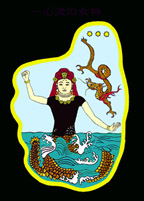
--- Kenpo Gokui
~~~~~~~~~~~~~~~~~~~~~~~~~~~
A.J.Advincula
HONORING FOUNDER
HONORING SHIMABUKU TATSUO
1908 - 1975 (Founder - Isshinryu Karate)
